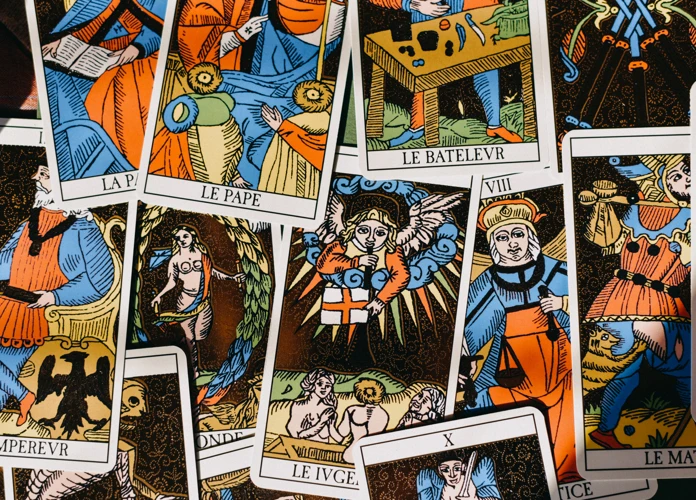Exploring the History and Symbolism of Tarot Deck Designs: Unveiling the enigmatic world of Tarot, this article delves into the captivating history and profound symbolism behind the designs of Tarot decks. From its ancient roots to its evolution in Europe, Tarot has fascinated and inspired people for centuries. The Major Arcana, Minor Arcana, and Court Cards each possess their own unique design elements, while the Fool, High Priestess, and Death cards offer deep insight into the symbolism within the Tarot. The influence of art movements such as Renaissance, Mannerism, and the Golden Dawn have contributed to the rich visual heritage of Tarot deck designs. Through exploring popular Tarot deck designs like the Rider-Waite-Smith, Thoth, and Marseille Tarot, we unravel the meanings behind card illustrations and their historical influences. The impact of Tarot on culture, including its connections to psychology, personal growth, and its portrayal in pop culture and media, showcases its enduring relevance today. Prepare to journey into the enchanting realm of Tarot deck designs, where ancient tradition and contemporary inspiration converge.
Contents
- The Origins of Tarot
- Tarot Deck Design Elements
- Symbolism in Tarot Designs
- Influence of Art Movements
- Popular Tarot Deck Designs
- Meanings Behind Card Illustrations
- Historical Influences on Design
- The Impact of Tarot on Culture
- Conclusion
-
Frequently Asked Questions
- 1. How old is the Tarot?
- 2. What is the purpose of Tarot cards?
- 3. How many cards are in a Tarot deck?
- 4. Can anyone learn to read Tarot cards?
- 5. Do Tarot cards predict the future?
- 6. Are Tarot cards related to witchcraft or occult practices?
- 7. Can Tarot cards be used for spiritual growth?
- 8. Is there a “right” way to interpret Tarot cards?
- 9. Can Tarot cards be used for decision-making?
- 10. Are all Tarot decks the same?
- References
The Origins of Tarot
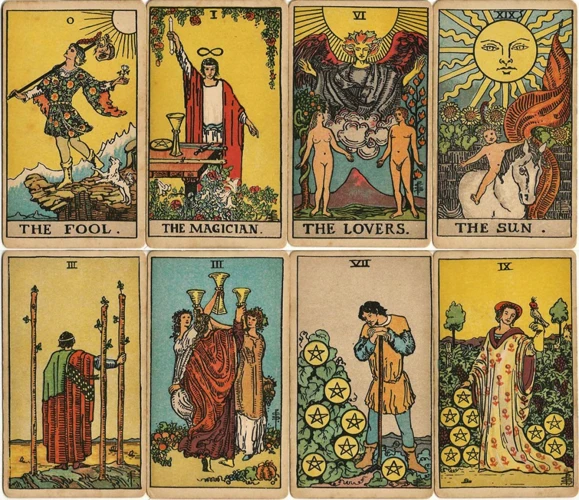
The origins of Tarot can be traced back to ancient times, where its mysterious roots intertwine with storytelling and divination practices. The exact origins of Tarot are shrouded in uncertainty and speculation, but many believe that its ancient beginnings can be found in Egypt or ancient China. Over time, Tarot cards made their way to Europe, specifically Italy and France, where they evolved into the familiar system we know today. These early European Tarot decks were used not only for divination but also for playing card games. The Tarot deck consists of 78 cards, divided into the Major Arcana and Minor Arcana. The Major Arcana tells a narrative of life’s journey, with cards like The Fool, The High Priestess, and Death, each representing different archetypes and symbolic meanings. The Minor Arcana, resembling a regular deck of playing cards, further adds depth to readings with its suits of Cups, Wands, Swords, and Pentacles. The Court Cards, including the Kings, Queens, Knights, and Pages, embody different personalities and qualities. Understanding the ancient beginnings and evolution of Tarot provides a fascinating glimpse into the rich history and symbolism embedded within these captivating cards.
Ancient Beginnings
Tarot has its origins deeply rooted in ancient civilizations, with the exact beginning remaining a subject of speculation and mystery. Two prevalent theories suggest its origins in either ancient Egypt or ancient China. Some researchers believe that the Tarot deck draws inspiration from the Book of Thoth, an ancient Egyptian text said to contain profound wisdom and knowledge. The connection between Tarot and ancient Egypt can be seen in the symbolism and imagery present in various Tarot decks, such as the iconic depiction of the Sphinx on The Chariot card or the presence of Egyptian gods and goddesses. Another theory suggests that Tarot finds its roots in ancient China, where playing cards known as “money-suited” cards were used for both gaming and divination purposes. These early Chinese playing cards later made their way to Europe, where their designs and meanings evolved over time into the Tarot system we know today.
The earliest documented evidence of Tarot dates back to the 15th century, with the emergence of the Visconti-Sforza deck in Italy. This deck, commissioned by the ruling Visconti and Sforza families, featured intricate and ornate designs that showcased the wealth and status of the noble families. These earlier Tarot decks were not only used for divination but also for playing card games. Over time, Tarot decks started to include additional cards, such as the Major Arcana, which depicted allegorical and symbolic scenes. The Tarot truly began to flourish during the Renaissance period, with artists and scholars incorporating esoteric symbolism and mystical concepts into their deck designs.
Despite the mysteries surrounding its origins, Tarot has undeniably stood the test of time, captivating generations with its enigmatic nature and timeless wisdom. Today, Tarot decks are widely available, with a myriad of designs and interpretations to choose from. Whether you are drawn to the traditional symbolism of the Rider-Waite-Smith deck or the esoteric depths of the Thoth Tarot, selecting your first Tarot deck is an important decision that should align with your personal preferences and spiritual inclinations. The ancient beginnings of Tarot continue to inspire and intrigue, offering a gateway to embark on a journey of self-discovery and connection with the divine.
Evolution in Europe
In the evolution of Tarot, Europe played a pivotal role in transforming the cards into what we recognize today. Tarot cards made their first appearance in Europe during the 14th century, where they were primarily used in the courts of nobility for entertainment and gambling. However, it was in the 18th and 19th centuries that Tarot experienced a resurgence in popularity and began to be seen as a tool for divination and spiritual exploration. During this time, influential occult societies such as the Hermetic Order of the Golden Dawn embraced Tarot and integrated it into their esoteric practices. The Golden Dawn’s study of Tarot, which emphasized symbolism, numerology, and elemental associations, greatly influenced subsequent Tarot designs. Notably, the Rider-Waite-Smith Tarot deck, created by artist Pamela Colman Smith and occultist Arthur Edward Waite in the early 20th century, became a foundational deck that defined the imagery and symbolism of Tarot for many generations. This deck featured intricate illustrations and included detailed symbolism on every card, making it highly accessible for both novice and experienced readers. The evolution of Tarot in Europe not only expanded its purpose from gaming to divination but also contributed to the development of Tarot as a deeply spiritual and introspective tool. To this day, the influence of European Tarot traditions can be seen in the countless deck variations and interpretations available to modern practitioners. Understanding the evolution of Tarot in Europe provides valuable insight into the rich lineage and diverse interpretations of this ancient practice.
Tarot Deck Design Elements
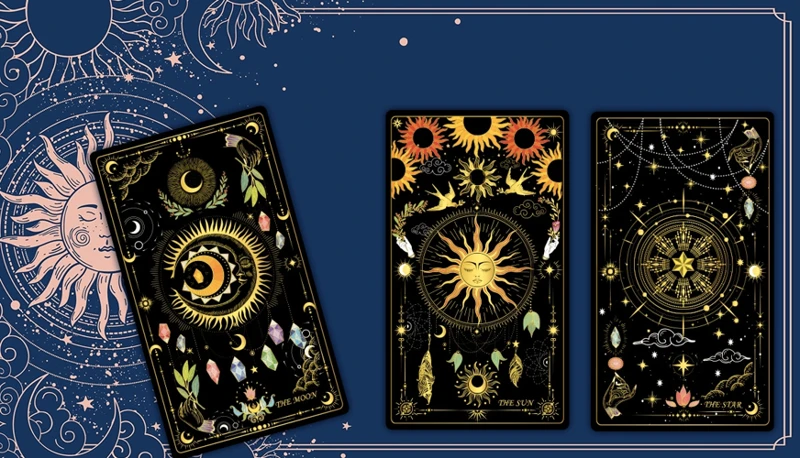
Tarot deck designs are imbued with a rich array of elements that contribute to their unique and captivating aesthetic. The Major Arcana, consisting of 22 cards, is often the focal point of Tarot deck designs. Each card represents a significant archetype, such as The Fool, The Magician, or The Chariot, and features intricate illustrations that convey deeper symbolic meanings. The Minor Arcana, comprising 56 cards divided into four suits – Cups, Wands, Swords, and Pentacles – showcase distinctive symbols and imagery that correspond to specific elements and aspects of life. The Court Cards, including the Kings, Queens, Knights, and Pages, incorporate elements of storytelling and character representation. These elements – from the alluring imagery of the Major Arcana to the symbolism found in the Minor Arcana and Court Cards – all contribute to the artistry and depth of Tarot deck designs. The selection of a Tarot deck is a personal and significant decision, as different decks may resonate with individuals based on their preferred symbolism, artistic style, or spiritual connection. Whether seeking a deck for divination, personal exploration, or spiritual growth, understanding the diverse design elements of Tarot decks can guide one’s choice and enhance their Tarot journey.
The Major Arcana
The Major Arcana in Tarot refers to a set of 22 cards that hold significant meaning and symbolism. Each card represents a pivotal moment or archetype in the human experience. These cards are often considered the heart and soul of the Tarot deck, carrying powerful messages and lessons for the seeker. Each card in the Major Arcana has a unique design and symbolism that contributes to its interpretation. From the iconic Fool card, representing new beginnings and taking risks, to the mysterious High Priestess card, symbolizing intuition and hidden knowledge, each card tells a story and offers profound insights. The Death card, despite its ominous name, represents transformation and rebirth, reminding us that change is a natural part of life’s cycles. The imagery and symbolism within the Major Arcana cards have deep connections to spirituality, psychology, and personal growth, making them a valuable tool for introspection and self-discovery. Whether you’re a beginner or an experienced Tarot reader, understanding the significance and interpretations of the Major Arcana cards can greatly enhance your Tarot practice. Consider exploring different Tarot decks and their interpretations of the Major Arcana to find a deck that resonates with you. You can learn more about selecting your first Tarot deck here. The Major Arcana invites us to dive deeper into the mysteries of life, offering guidance, wisdom, and a profound understanding of the human experience.
The Minor Arcana
The Minor Arcana, a vital component of the Tarot deck, consists of 56 cards that offer insights into the everyday aspects of life and human experiences. These cards, divided into four suits – Cups, Wands, Swords, and Pentacles – depict various situations and emotions individuals encounter. Each suit carries its own distinct symbolism and represents different areas of life.
1. Cups: Symbolizing emotions, relationships, and creativity, the Cups suit reflects the realm of the heart and intuition. It delves into matters of love, compassion, and spirituality. Cards like the Ace of Cups signify new beginnings and the potential for emotional fulfillment, while the Ten of Cups represents harmony and emotional stability.
2. Wands: Representing energy, ambition, and passion, the Wands suit embodies the realm of action and personal drive. It signifies creativity, inspiration, and the pursuit of goals. The Ace of Wands signifies new opportunities and creative potential, while the Ten of Wands embodies the culmination of hard work and perseverance.
3. Swords: Associated with intellect, challenges, and decision-making, the Swords suit explores the realm of the mind and thoughts. It represents communication, conflicts, and mental clarity. The Ace of Swords signifies clarity and breakthroughs, while the Ten of Swords represents the end of a difficult cycle, and the opportunity for new beginnings.
4. Pentacles: Symbolizing material possessions, wealth, and practicality, the Pentacles suit pertains to the physical realm and the tangible aspects of life. It encompasses financial matters, career paths, and physical well-being. The Ace of Pentacles represents new opportunities and abundance, while the Ten of Pentacles signifies family, stability, and long-term success.
Together, the Minor Arcana offers a comprehensive understanding of various aspects of life, allowing for a detailed exploration of practical matters, personal growth, and emotional experiences. Each card within the Minor Arcana holds its own unique meanings and interpretations, enabling diviners to gain insights into specific areas of concern or inquiry. Understanding the significance of each suit and its associated cards allows for a deeper connection with the Tarot deck and the messages it conveys.
The Court Cards
In Tarot, the Court Cards hold a special place in the deck, representing a diverse cast of characters that embody different personalities and qualities. These cards act as the “royalty” or “nobility” of the deck and are often associated with individuals or groups of people. There are four Court Card ranks in each suit – Kings, Queens, Knights, and Pages, each with its own symbolism and significance. The Kings are the embodiment of authority, leadership, and mastery. They possess wisdom and represent a sense of power and control. The Queens, on the other hand, embody nurturing and intuitive qualities. They represent femininity, emotional depth, and nurturing aspects of life. The Knights symbolize action, movement, and drive. They are the dynamic force within the Court Cards, representing ambition and the pursuit of goals. Lastly, the Pages are associated with youthfulness, curiosity, and learning. They represent a fresh perspective and the beginning stages of a journey. Together, these Court Cards offer insight into various aspects of human nature and relationships. During a Tarot reading, the Court Cards can offer guidance, advice, or represent specific individuals in the querent’s life. Recognizing the unique qualities and symbolism of each Court Card can provide a deeper understanding of the situations and personalities involved in a reading. Whether interpreting the characteristics of a King, Queen, Knight, or Page, the Court Cards bring depth and nuance to Tarot readings, enhancing the spiritual and introspective journey.
Symbolism in Tarot Designs
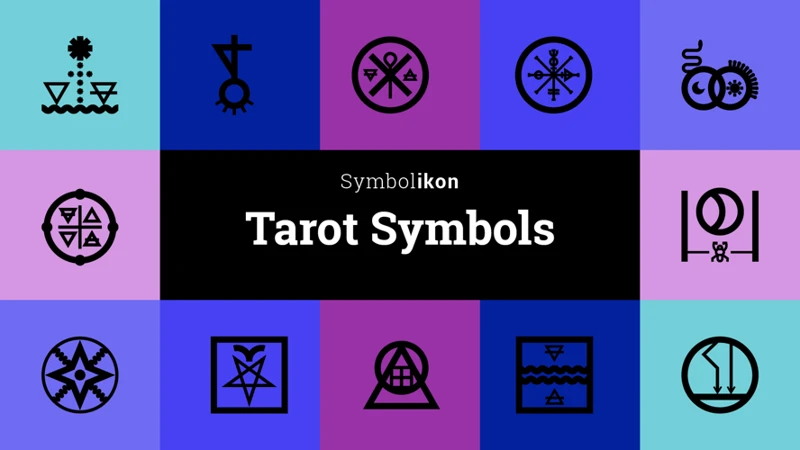
Symbolism is a key aspect of Tarot designs, imbuing each card with layers of meaning and interpretation. The Fool card, for example, represents new beginnings, stepping into the unknown, and embracing spontaneity and trust in the journey ahead. The High Priestess card embodies wisdom, intuition, and hidden knowledge, often associated with the divine feminine energy. Death, contrary to its literal interpretation, symbolizes transformation, rebirth, and letting go of the old to make way for the new. Each card in the Tarot deck carries its own symbolism, drawing from a blend of cultural, spiritual, and historical influences. From the intricate details in the artwork to the colors chosen, every element holds significance and contributes to the overall meaning of the card. Whether exploring the Fool’s leap of faith, the High Priestess’s inner knowing, or the transformative power of Death, the symbolism in Tarot designs invites us to delve deeper into the mysteries of life and tap into our own intuition and spirituality.
The Fool Card
The Fool card is regarded as a pivotal and intriguing card in Tarot deck designs. Represented by a carefree individual on a journey, the Fool card symbolizes new beginnings, spontaneity, and embracing the unknown. In the Rider-Waite-Smith Tarot deck, the Fool is depicted as a young man standing at the edge of a cliff, unaware of the potential dangers ahead. This card encourages individuals to take risks, trust their instincts, and embark on new adventures. The Fool is often associated with the element of Air, representing intellect, creativity, and open-mindedness. This card is closely linked to the idea of spiritual enlightenment and self-discovery, as it encourages individuals to let go of fear and embrace their true potential. The symbolism of the Fool card extends beyond its individual design, with variations across different Tarot decks incorporating their own unique interpretations. Some decks provide additional details, such as animals or objects held by the Fool, adding depth and nuance to the card’s meaning. The Fool card embodies the spirit of spiritual exploration and the journey of self-discovery, making it a significant and thought-provoking card in Tarot deck designs. For those seeking a deeper understanding of Tarot deck spirituality, exploring the symbolism of the Fool card is an enlightening experience. (A link to Tarot Deck Spirituality further connects readers to the broader exploration of spiritual aspects within Tarot decks.)
The High Priestess Card
The High Priestess card is a powerful symbol within the Tarot deck, representing intuition, wisdom, and spiritual insight. As one of the Major Arcana cards, it holds great significance and offers profound guidance to those who encounter it. The High Priestess is depicted as a mysterious figure, sitting on a throne between two pillars, with a veil behind her. She holds a scroll or a book, signifying hidden knowledge and esoteric wisdom. The pillars symbolize duality, with the black pillar representing the masculine energy of action and the white pillar representing the feminine energy of intuition and reflection. The veil behind her represents the hidden realms of the subconscious and the mysteries that lie beyond the physical world. The High Priestess is a reminder to trust our intuition and tap into the depths of our inner wisdom. This card often appears when we need to delve into our subconscious, connect with our intuition, and listen to the whispers of our soul. In readings, the High Priestess encourages introspection, reflection, and spiritual exploration. She reminds us to trust our inner voice and follow the path that aligns with our truest selves. The symbolism and messages conveyed through the High Priestess card make it a profound and thought-provoking card within the Tarot deck. Its influence can be felt in various aspects of life, guiding individuals towards self-discovery and spiritual growth.
The Death Card
The Death Card: In Tarot, the Death card is one of the most feared and misunderstood cards, evoking images of physical demise and endings. However, its symbolism goes beyond literal death and represents profound transformation and rebirth. Depicted as a skeleton clad in armor riding a white horse, the Death card carries a black flag emblazoned with a white rose, which symbolizes purity and spiritual growth. The card signifies endings, letting go, and the natural cycles of life. It serves as a reminder that in order to embrace new beginnings, old patterns and beliefs must be released. The Death card encourages us to confront our fears and embrace the transformative power of change. It signifies the end of a phase or situation, clearing the way for something new and necessary. This card does not signify literal death, but rather the death of old habits, relationships, or ways of thinking that no longer serve us. The Death card is a powerful and important part of the Tarot deck, reminding us that with every ending comes the opportunity for rebirth and personal growth.
Influence of Art Movements
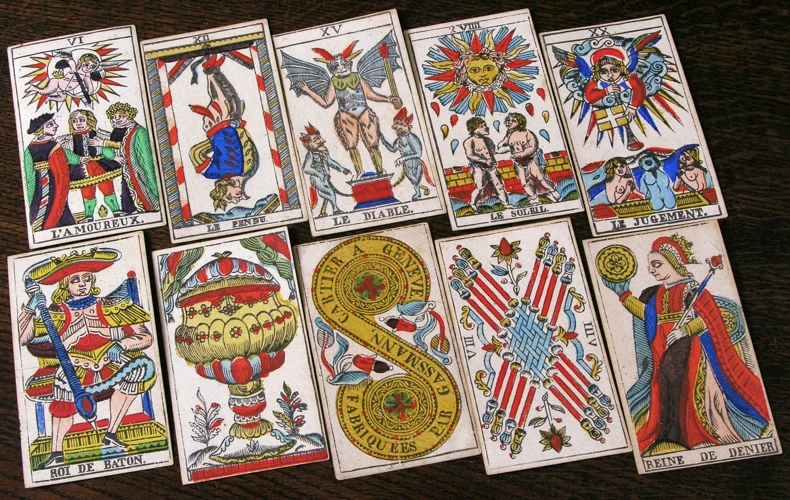
The influence of art movements on Tarot deck designs is a testament to the evolution and adaptability of this ancient divination tool. Throughout history, various art movements have left their mark on Tarot, influencing both the aesthetics and the symbolism portrayed on the cards. The Renaissance and Mannerism periods, known for their focus on humanism and the revival of classical art, inspired Tarot deck artists to incorporate elaborate details, rich colors, and a sense of grandeur into their designs. The imagery became more sophisticated, drawing inspiration from mythological and biblical stories. Another significant influence on Tarot can be attributed to the Golden Dawn, a secret society in the late 19th and early 20th centuries. The Golden Dawn’s exploration of esoteric teachings and mysticism brought about a resurgence of interest in Tarot and spurred the creation of unique Tarot deck designs that reflect its occult teachings. Contemporary inspirations also play a role in Tarot design, with artists drawing from various art styles and movements to create decks that resonate with modern sensibilities. The influence of art movements on Tarot designs infuses these divination tools with a rich tapestry of cultural and artistic expressions, making each deck a unique and captivating work of art.
Renaissance and Mannerism
In the realm of Tarot deck designs, the Renaissance and Mannerism art movements hold significant influence. During the Renaissance period, which spanned from the 14th to the 17th century, there was a renewed interest in classical Greek and Roman art, culture, and knowledge. This era gave birth to some of the most iconic Tarot decks, such as the Visconti-Sforza Tarot and the Estensi Tarot. These decks showcased intricate and detailed illustrations, often featuring allegorical and mythological symbolism, mirroring the aesthetics of Renaissance art. The use of vibrant colors, fine brushwork, and attention to detail exemplified the artistic ingenuity of the time. The Mannerism movement followed the Renaissance, characterized by its exaggerated proportions, elongated figures, and dramatic poses. This artistic style can be seen in Tarot decks like the Tarot de Marseille, with its elongated figures and intricate ornamentation. The Mannerist influence on Tarot deck designs added a unique and theatrical flair to the cards, enhancing their visual appeal and symbolic depth. The blend of Renaissance and Mannerist artistic elements in Tarot designs created a harmonious fusion of beauty, symbolism, and storytelling. This historical artistic backdrop continues to shape and inspire modern Tarot deck designs, showcasing the enduring impact of these influential art movements. (source: tarot-deck-publishers-influence)
The Golden Dawn
The Golden Dawn, a secretive and influential occult organization founded in the late 19th century, played a significant role in shaping the symbolism and interpretations of Tarot. Led by prominent figures like Samuel Liddell MacGregor Mathers and Arthur Edward Waite, the Golden Dawn sought to explore the mystical and esoteric aspects of various spiritual traditions. One of their key contributions to Tarot was the development of the Hermetic Order of the Golden Dawn’s Tarot deck. This deck, also known as the Golden Dawn Tarot, featured intricate artwork and incorporated elements from astrology, Kabbalah, and other occult principles.
The Golden Dawn’s approach to Tarot emphasized the significance of symbolism and esoteric correspondences. They assigned astrological and elemental associations to the cards, providing a deeper layer of divinatory interpretation. For example, the Golden Dawn associated the Major Arcana card, The Hermit, with the astrological sign of Virgo and the element of Earth, highlighting its attributes of introspection, wisdom, and practicality.
Additionally, the Golden Dawn’s Tarot deck incorporated various occult symbols and imagery, including Hebrew letters, Egyptian hieroglyphs, and alchemical symbols. These intricate designs served as visual triggers for deeper understanding and contemplation. The Golden Dawn’s influence on Tarot extended not only to their unique deck but also to their comprehensive system of Tarot interpretation and ritual practices.
The legacy of the Golden Dawn and their Tarot teachings continues to be felt in contemporary Tarot practices. Their emphasis on symbolism and esoteric correspondences has permeated the Tarot community, shaping the way many readers approach Tarot readings and delve into the deeper meanings of the cards. The Golden Dawn’s Tarot deck remains a prominent and highly sought-after deck for enthusiasts and collectors seeking to explore the intricate web of symbolism and esoteric wisdom woven into the cards.
Contemporary Inspirations
Contemporary inspirations have played a significant role in shaping the design aesthetics of modern Tarot decks. In recent years, there has been a resurgence of interest in Tarot, resulting in a diverse range of deck designs that draw inspiration from various sources. One prominent influence is the world of fantasy and mythology, with decks featuring enchanting creatures, magical landscapes, and epic storytelling. Artists have also drawn inspiration from popular culture, incorporating elements from movies, books, and television shows into their Tarot designs. This fusion of modern references and traditional Tarot symbolism creates a unique and relatable experience for readers. Additionally, contemporary art movements such as surrealism, minimalism, and abstract expressionism have influenced the visual language of Tarot decks, giving them a fresh and innovative look. The use of digital art and graphic design techniques has also allowed for intricate and visually stunning deck designs. Tarot decks have embraced inclusivity by featuring diverse representations of race, gender, body types, and sexual orientations, reflecting the recognition and celebration of underrepresented communities. These contemporary inspirations have breathed new life into Tarot deck designs, attracting a wider audience and ensuring the relevance and evolution of this ancient practice in the modern age.
Popular Tarot Deck Designs
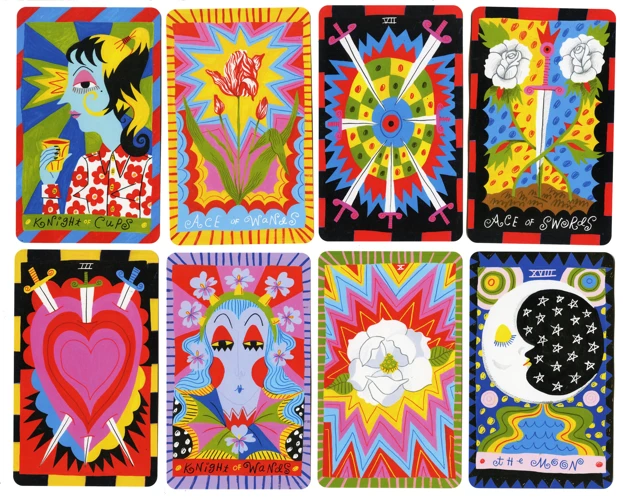
When it comes to popular Tarot deck designs, there are several iconic options that have captured the imaginations of Tarot enthusiasts worldwide. The Rider-Waite-Smith Tarot, created by Arthur Edward Waite and artist Pamela Colman Smith, is one of the most widely recognized and influential Tarot decks. Known for its intricate illustrations and symbolism, the Rider-Waite-Smith Tarot has become a standard reference for Tarot readers. Another noteworthy deck is the Thoth Tarot, designed by Aleister Crowley and painted by Lady Frieda Harris. This deck incorporates elements of astrology, Qabalah, and ceremonial magic, resulting in a visually striking and esoteric deck. The Marseille Tarot, with its vibrant colors and simplified illustrations, dates back to the 16th century and represents the traditional style of Tarot deck designs. Each of these popular Tarot deck designs offers a unique perspective and visual language, allowing readers to connect with the cards and access their inherent wisdom. Whether drawn to the classic symbolism of Rider-Waite-Smith, the mystical allure of Thoth, or the timeless charm of Marseille, there is a Tarot deck design to suit every seeker’s preference.
Rider-Waite-Smith Tarot
The Rider-Waite-Smith Tarot, often referred to as the RWS Tarot, is one of the most widely recognized and influential Tarot deck designs. Created by artist Pamela Colman Smith and occultist Arthur Edward Waite in the early 20th century, this deck revolutionized Tarot imagery and set a new standard for deck designs that followed. The RWS Tarot features 78 cards, divided into the Major Arcana and Minor Arcana, each beautifully illustrated with rich symbolism. The Major Arcana cards in this deck convey the archetypal journey of the Fool’s quest for self-discovery and enlightenment, while the Minor Arcana cards depict scenes that reflect everyday experiences and situations. One of the standout features of the RWS Tarot is its expressive and evocative artwork, which incorporates vibrant colors and intricate details. Each card tells a story through its imagery, making it accessible to both beginners and experienced readers. The deck’s iconic imagery, such as The Fool’s leap of faith, The High Priestess’s mysterious veil, and Death’s transformative power, has become deeply embedded in Tarot tradition. The Rider-Waite-Smith Tarot deck’s enduring popularity and timeless design have made it a staple for Tarot enthusiasts and readers worldwide, serving as a foundational reference point for many other Tarot deck designs that followed its creation.
Thoth Tarot
The Thoth Tarot, also known as the Crowley-Harris Tarot, is a highly influential and esoteric Tarot deck created by Aleister Crowley and Lady Frieda Harris. This deck is based on Crowley’s occult philosophy and Harris’s artistic talents, resulting in a rich and intricate deck with deep symbolic meanings. The Thoth Tarot deck incorporates elements of astrology, alchemy, and various esoteric systems, making it a favorite among occultists and those seeking a deeper understanding of the Tarot. The artwork in the Thoth Tarot is vibrant and complex, with detailed imagery that invites contemplation and exploration. Each card in the deck carries multiple layers of symbolism, allowing for deep and insightful readings. The Thoth Tarot deck includes the traditional Major Arcana and Minor Arcana, with Crowley’s own interpretations and associations. It has become highly regarded not only for its esoteric significance but also for its artistic beauty. The Thoth Tarot continues to captivate and inspire Tarot enthusiasts and occult practitioners alike with its intricate symbolism and profound wisdom embedded within each card.
Marseille Tarot
The Marseille Tarot, also known as the Tarot de Marseille, is one of the oldest and most influential Tarot deck designs. Its origins can be traced back to the 17th century in France, particularly in the city of Marseille. This deck is characterized by its simple yet bold and vibrant imagery. The Marseille Tarot consists of 78 cards, with 22 Major Arcana and 56 Minor Arcana divided into four suits: Cups, Coins, Swords, and Batons. Each card in the Marseille Tarot features a unique design, with numbered pips representing the suit cards and intricately illustrated Major Arcana cards.
The Marseille Tarot has a distinct traditional aesthetic, with its use of primary colors, detailed line work, and lack of scenic backgrounds. The cards in this deck typically feature a central figure or symbol against a plain, solid-colored background. The imagery is often minimalist and symbolic, allowing the reader to focus on the core meaning of each card.
The Marseille Tarot has had a profound influence on the development of Tarot deck designs throughout history. Its iconic imagery has been replicated and adapted by numerous artists and publishers over the centuries. The deck’s popularity spread beyond France and became widely used for divination and occult practices across Europe.
The Marseille Tarot’s enduring appeal lies in its timeless design and archetypal symbolism. Despite its simplicity, this deck offers powerful insights and intuitive guidance to those who work with it. Whether you are a Tarot enthusiast or a curious seeker, exploring the Marseille Tarot opens the door to a deep understanding of Tarot’s history and the significance of its symbolism.
Meanings Behind Card Illustrations
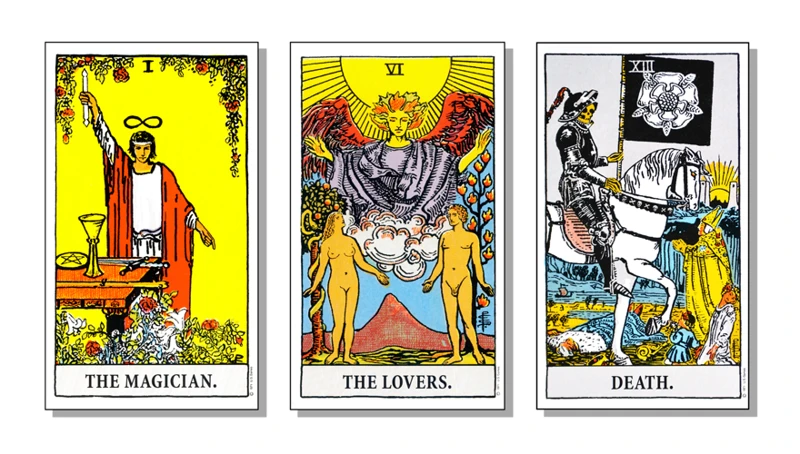
The illustrations on Tarot cards hold profound meanings that provide insight and guidance in readings. Each card depicts a unique scene or symbol that represents a specific concept or theme. For instance, The Fool card often portrays a figure stepping off a cliff, symbolizing new beginnings, innocence, and taking risks. The Lovers card commonly depicts a couple surrounded by an angel, representing love, partnerships, and the choices we make in relationships. The Tower card showcases a crumbling tower struck by lightning, symbolizing sudden change, destruction, and the breaking down of old structures. These illustrations draw upon archetypal imagery and universal symbols that tap into the collective unconscious, allowing readers to tap into deeper meanings and uncover hidden truths. The rich symbolism within Tarot card illustrations makes them powerful tools for self-reflection, introspection, and gaining clarity on life’s challenges and opportunities.
The Fool Card
The Fool card is one of the most intriguing and symbolic cards in the Tarot deck. Depicted as a young man on a journey, the Fool represents new beginnings, spontaneity, and a sense of adventure. In most Tarot decks, the Fool is depicted as a carefree individual with a bindle slung over his shoulder, symbolizing his lightness and freedom from material possessions. He is often portrayed standing at the edge of a cliff or precipice, representing the leap of faith required to embark on new endeavors. The Fool is associated with the element of Air, which represents intellectual curiosity, open-mindedness, and a willingness to take risks.
The Fool card is often interpreted as a call to embrace uncertainty and embrace the unknown. It encourages us to step outside of our comfort zones and explore new possibilities. The Fool is a reminder to trust in the journey of life and to have faith in ourselves, even when faced with the unknown. It signifies a time of new beginnings, where we are free to pursue our dreams and take chances without fear of failure.
Symbolically, the Fool represents the archetype of the eternal child or the inner child within us all. This card reminds us to reconnect with our sense of wonder and playfulness. The Fool encourages us to approach life with a sense of curiosity and openness, reminding us that sometimes the greatest growth comes from embracing the unexpected.
In readings, the Fool can have various interpretations depending on its placement and surrounding cards. It can signify a need to take a leap of faith, trust our instincts, or embark on a new adventure. It can also serve as a reminder to let go of fear or self-doubt and embrace the possibilities that await us. Whatever the interpretation, the Fool card holds a special place in the Tarot deck, inviting us to embrace the journey of life’s endless possibilities with childlike wonder and enthusiasm.
The Lovers Card
The Lovers card in the Tarot deck is a symbol of love, harmony, and choices. Depicted with a man and a woman standing in a paradise-like setting, it represents the union of opposites and the power of choice in matters of the heart. The card often portrays an angel hovering above the couple, symbolizing guidance and spiritual influences. The Lovers card embodies the idea of attraction and connection, not just in romantic relationships, but also in friendships and partnerships. It signifies the need to make choices and decisions based on values, ethics, and personal integrity. The card prompts individuals to consider their desires, emotions, and the consequences of their choices. In readings, the Lovers card suggests the need for balance, unity, and the integration of masculine and feminine energies. It encourages individuals to listen to their intuition and follow their hearts when faced with important decisions. Ultimately, the Lovers card represents the potential for deep connections, personal growth, and the transformative power of love.
The Tower Card
The Tower card is one of the most striking and powerful cards in the Tarot deck. Depicting a tall tower being struck by lightning, it is a card that symbolizes sudden upheaval and destruction. The Tower represents a sudden, unexpected change or crisis that shakes the very foundations of a person’s life or belief system. It signifies a breaking down of old structures, ideas, or ways of being to make way for new growth and transformation. This card is often associated with moments of profound insight, awakening, and enlightenment, as the destruction forces individuals to confront their own limitations and embrace change. The Tower represents a necessary process of growth, even though it can be uncomfortable and unsettling at times. It serves as a reminder that sometimes, in order to move forward and evolve, old structures must be dismantled. Despite its initial appearance of chaos and destruction, the Tower card ultimately carries a message of liberation, freedom, and resilience. It encourages individuals to embrace change, adapt to challenging circumstances, and find the inner strength to rebuild and create a stronger foundation.
Historical Influences on Design
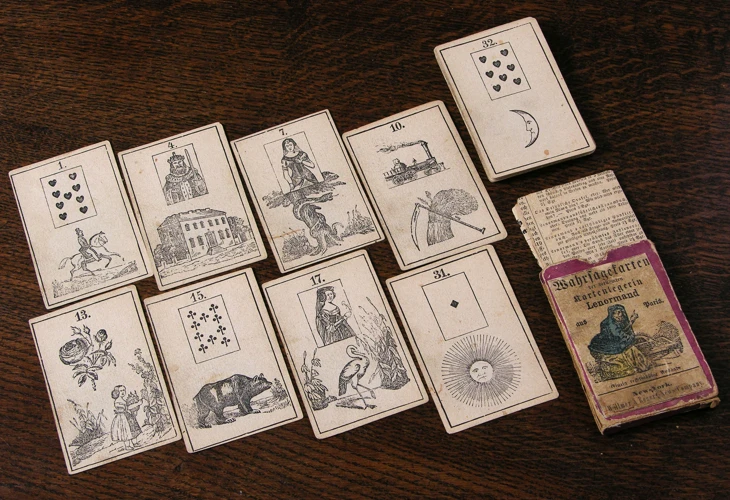
The design of Tarot decks has been heavily influenced by various historical and esoteric traditions, which have shaped the visual language and symbolism depicted on the cards. One significant influence is Christian symbolism, with many Tarot decks incorporating biblical references and iconography. The imagery of the Major Arcana cards often draws inspiration from Christian stories and figures, such as The Hierophant representing the Pope or The Devil symbolizing temptation. Another influential aspect is alchemy and hermeticism, where cards like The Magician and The World reflect the alchemical journey of transformation. Astrology also plays a key role in Tarot design, with cards like The Star and The Moon representing celestial energies and astrological associations. These historical influences not only lend depth and context to the images depicted on the cards but also connect Tarot to broader philosophical and spiritual traditions.
Christian Symbolism
Christian symbolism plays a significant role in the design and interpretation of Tarot cards. The fusion of Christian imagery with the esoteric symbolism of Tarot creates a unique blend that sparks intrigue and contemplation. Here are some key Christian symbols commonly found in Tarot decks:
- The Cross: The cross is a powerful symbol in Christianity, representing sacrifice, redemption, and resurrection. In Tarot, it often appears in cards like The Hanged Man and The Emperor, symbolizing self-sacrifice, spiritual wisdom, and authority.
- The Dove: The dove is a symbol of peace and the Holy Spirit in Christianity. In Tarot, it can be seen in cards like The Lovers, representing harmony, love, and divine guidance.
- The Chalice: The chalice, also known as the Holy Grail, symbolizes divine grace and spiritual fulfillment. It can be found in cards like the Ace of Cups, representing emotional abundance and spiritual awakening.
- The Crown of Thorns: The crown of thorns is associated with the crucifixion of Jesus and represents suffering and sacrifice. In Tarot, it can appear in cards like the Five of Wands, indicating conflict, struggle, and the need for perseverance.
- The Angel: Angels are celestial beings associated with divine guidance and protection. In Tarot, they are often present in cards like The Judgement, symbolizing spiritual awakening, transformation, and divine intervention.
These Christian symbols, intertwined with the broader Tarot symbolism, add depth and layers of meaning to the cards. They invite contemplation on spiritual themes, morality, and the search for deeper truths. The use of Christian symbolism in Tarot reflects the influence of religious traditions and adds a profound dimension to the interpretation of card readings.
Alchemy and Hermeticism
Alchemy and Hermeticism have had a profound influence on the symbolism and meanings behind Tarot designs. Alchemy, a philosophical and proto-scientific discipline, sought to transform base materials into precious substances and achieve spiritual enlightenment. Hermeticism, on the other hand, is a spiritual and philosophical tradition rooted in the teachings of Hermes Trismegistus, blending elements of Egyptian mythology, Greek philosophy, and esoteric wisdom. Both Alchemy and Hermeticism emphasize the interconnectedness of the material and spiritual worlds, as well as the pursuit of inner transformation and divine knowledge. In Tarot, these principles are reflected in various ways. The symbolism of alchemical processes, such as the transmutation of lead into gold or the purifying fire, can be found in cards like The Tower, The Sun, and The Star. These cards represent moments of upheaval, revelation, and spiritual growth. Similarly, Hermetic teachings are encoded throughout the Tarot, particularly in the concept of “as above, so below” or the microcosm-macrocosm correspondence. This principle asserts that the patterns and structures of the universe are mirrored in individual human experiences. As such, Tarot cards serve as a tool for exploring the depths of the human psyche, connecting the personal and universal aspects of existence. The fusion of Alchemy and Hermeticism with Tarot creates a rich tapestry of meaning and symbolism, inviting seekers to embark on an esoteric journey towards self-discovery and spiritual enlightenment.
Astrological Associations
Astrological associations play a significant role in Tarot, merging the ancient practices of astrology and divination into a cohesive whole. Each card in the Tarot deck is connected to specific astrological signs, planets, and celestial energies, adding another layer of symbolism and meaning. The astrological associations can provide deeper insights into the card’s interpretation and offer guidance in readings.
The Major Arcana cards often have strong astrological connections. For example, The Empress card is closely tied to the planet Venus, embodying qualities of love, beauty, and abundance. Similarly, The Sun card symbolizes vitality and self-expression, aligning with the astrological sign of Leo. These astrological connections allow readers to tap into the energies associated with each card and interpret their messages accordingly.
The Minor Arcana cards also have astrological correspondences through their suits. The suit of Cups is linked to the water element and is connected to the astrological signs of Cancer, Scorpio, and Pisces. Cups represent emotions, intuition, and relationships. The suit of Wands, associated with the fire element, aligns with Aries, Leo, and Sagittarius. Wands represent creativity, action, and passion. The suit of Swords corresponds to the air element and signs such as Gemini, Libra, and Aquarius. Swords symbolize intellect, communication, and conflict resolution. Lastly, the suit of Pentacles is tied to the earth element and can be linked to Taurus, Virgo, and Capricorn. Pentacles represent material abundance, stability, and practicality.
By understanding the astrological associations within Tarot, readers can uncover deeper layers of meaning and context in their readings. These connections allow for a more comprehensive interpretation of the cards, merging the celestial energies with the symbolic imagery of the Tarot. Whether seeking guidance on partnerships, career decisions, or personal growth, exploring the astrological associations can provide valuable insights and guidance throughout the reading process.
The Impact of Tarot on Culture
The impact of Tarot on culture has been profound, extending beyond its traditional use as a tool for divination. The psychological and personal growth aspects of Tarot have drawn many individuals to explore its depths. Tarot readings can offer valuable insights, helping people gain clarity, explore their emotions, and navigate life’s challenges. Additionally, Tarot has permeated popular culture and media, appearing in movies, television shows, and literature. Its archetypal imagery and symbolism have sparked fascination and intrigue among artists, writers, and filmmakers, who often use Tarot as a source of inspiration. Tarot has influenced various artistic and creative endeavors, ranging from fashion to music. Its enigmatic allure continues to captivate and shape our cultural landscape, making Tarot a timeless and influential force in society.
Psychology and Personal Growth
The field of psychology has a strong connection with Tarot, as it offers insights into personal growth and self-discovery. Many individuals find solace and introspection through Tarot readings, using the cards as a tool for gaining self-awareness and understanding their emotions, thoughts, and behaviors. Psychologically, Tarot can tap into the subconscious mind, unveiling hidden desires, fears, and conflicts. Through the archetypal images and symbols depicted in Tarot cards, individuals can explore and analyze their own psyche, shedding light on their unconscious motivations and patterns. Tarot readings can serve as a form of therapy, providing a safe space for people to explore their emotions, relationships, and life choices. By examining the narratives and themes present in Tarot spreads, individuals can gain clarity, find healing, and ultimately embark on a journey of personal growth and self-empowerment. Whether used for self-reflection or in conjunction with psychological therapy, Tarot can be an invaluable tool for those seeking to deepen their understanding of themselves and cultivate personal growth.
Anchor: Tarot deck spirituality
Pop Culture and Media
Tarot has become increasingly prominent in pop culture and media, making appearances in films, television shows, literature, and music. Its imagery and symbolism have captured the imagination of artists, writers, and creators across various mediums. In movies like “The Matrix” and “Inception,” Tarot cards are used to depict themes of fate, destiny, and the exploration of the subconscious mind. In TV series like “American Horror Story” and “Penny Dreadful,” Tarot cards are often used to foreshadow events, add suspense, or reveal character intentions. The allure of Tarot has also been embraced by contemporary literature, with authors like Neil Gaiman and Terry Pratchett incorporating Tarot elements into their works. Musicians and bands have been inspired by Tarot, with album covers adorned with Tarot imagery and songs that explore the mystical themes evoked by the cards. Tarot’s infiltration into popular culture and media not only demonstrates its enduring fascination but also reflects its ability to resonate with a diverse audience and captivate the collective imagination. Whether as a tool for introspection or a visual motif in storytelling, Tarot has cemented its presence in the creative realm, leaving an indelible mark on popular culture.
Conclusion
The of this exploration into the history and symbolism of Tarot deck designs reveals the enduring impact and fascination that Tarot holds in our society. From its ancient origins to its evolution and adaptation in Europe, Tarot has captured the imagination of countless individuals throughout history. The intricate designs of the Major Arcana, Minor Arcana, and Court Cards, along with the profound symbolism they carry, provide a rich and diverse visual tapestry for readers and enthusiasts to explore. The influence of various art movements, such as the Renaissance, Mannerism, and the Golden Dawn, has shaped the aesthetics and themes of Tarot deck designs. Meanwhile, the popularity of Tarot remains evident through the continued appreciation and reverence for classic decks like the Rider-Waite-Smith, Thoth, and Marseille Tarot. The meanings behind card illustrations, deeply rooted in historical influences like Christian symbolism, alchemy and hermeticism, and astrological associations, add depth and complexity to Tarot readings. Tarot’s impact on culture extends beyond divination, as it has found its way into psychology, personal growth, and has been widely portrayed and referenced in pop culture and media. Tarot has truly become a universal language, bridging the gap between the spiritual and the everyday. In conclusion, exploring the history and symbolism of Tarot deck designs uncovers a world of intrigue, allowing us to connect with ancient wisdom while embracing the contemporary interpretations that continue to shape Tarot’s relevance and significance in our lives.
Frequently Asked Questions
1. How old is the Tarot?
The exact origins of Tarot are uncertain, but it is believed to have originated in ancient times, possibly in Egypt or ancient China. However, the Tarot as we know it today began to take shape in Europe around the 14th century.
2. What is the purpose of Tarot cards?
Tarot cards serve multiple purposes. They can be used for divination, providing insights and guidance into one’s life and future. Tarot cards are also utilized for self-reflection, personal growth, and as tools for creativity and storytelling.
3. How many cards are in a Tarot deck?
A traditional Tarot deck consists of 78 cards. This includes the Major Arcana, which comprises 22 cards representing significant life events, and the Minor Arcana, which consists of 56 cards divided into four suits.
4. Can anyone learn to read Tarot cards?
Yes, anyone can learn to read Tarot cards. It is a skill that can be developed with practice, study, and a connection to one’s intuition. There are plenty of resources available, such as books, online courses, and workshops, to help beginners get started.
5. Do Tarot cards predict the future?
Tarot cards do not predict the future with absolute certainty. Instead, they offer insights, guidance, and potential outcomes based on the energy and symbolism depicted in the cards. The interpretation of Tarot cards is subjective and can vary depending on the reader and the context of the reading.
While Tarot cards have been associated with occult practices, they are not inherently tied to witchcraft. Tarot can be used by individuals of various spiritual and religious beliefs as a tool for self-reflection, personal insight, and guidance.
7. Can Tarot cards be used for spiritual growth?
Yes, Tarot cards can be used as a tool for spiritual growth and self-discovery. They can help individuals gain insights into their subconscious patterns, emotions, and spiritual journey. Tarot can facilitate introspection, self-awareness, and personal transformation.
8. Is there a “right” way to interpret Tarot cards?
There is no definitive “right” way to interpret Tarot cards. Interpretation is subjective and can vary depending on the reader’s intuition, knowledge of the card meanings, and the context of the reading. Each reader brings their own unique perspective and insight to the cards.
9. Can Tarot cards be used for decision-making?
Yes, Tarot cards can be used as a tool for decision-making. They can offer different perspectives, insights, and potential outcomes to help individuals make informed choices. However, it’s important to remember that the final decision rests with the individual and not solely on the guidance of the cards.
10. Are all Tarot decks the same?
No, there are countless variations of Tarot decks available today. Different Tarot decks may have different artwork, themes, and interpretations of the card meanings. Some popular Tarot decks include the Rider-Waite-Smith Tarot, Thoth Tarot, and Marseille Tarot, each with its own unique design and symbolism.
